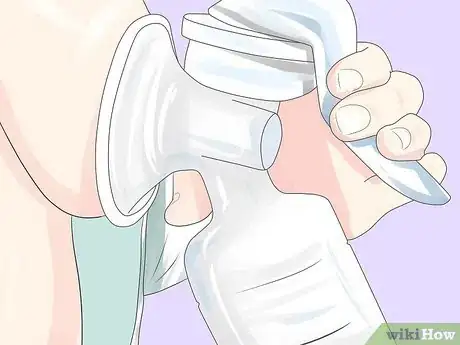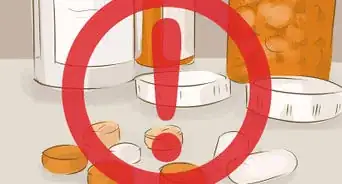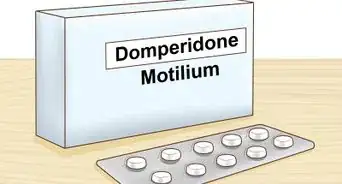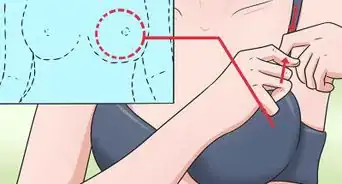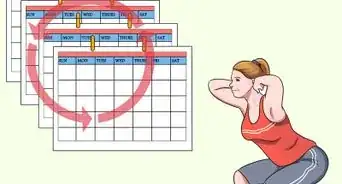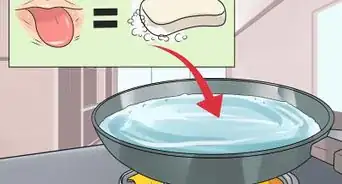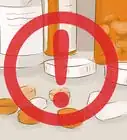This article was co-authored by wikiHow staff writer, Luke Smith, MFA. Luke Smith is a wikiHow Staff Writer. He's worked for literary agents, publishing houses, and with many authors, and his writing has been featured in a number of literary magazines. Now, Luke writes for the content team at wikiHow and hopes to help readers expand both their skillsets and the bounds of their curiosity. Luke earned his MFA from the University of Montana.
There are 8 references cited in this article, which can be found at the bottom of the page.
Learn more...
A Haakaa pump is a valuable addition to any mom’s breastfeeding bag. “Haakaa” is the name brand of a silicone breast pump, which is a basic breast milk collector that uses passive suction to attach and collect milk, as opposed to an electric or manual pump, which actively express milk. Haakaa pumps are discreet and easy to use, and we’ll show you how. We’ll also show you how to wash your silicone pump, store collected milk, and answer some of your most pressing questions.
Things You Should Know
- Place the pump flange over your nipple, with the flap folded backward.
- Squeeze the base of the pump and fold the flap forward again. Then release your grip to suction the pump to your breast.
- Remove the pump by sliding your finger under the lip of the flange to break the suction.
- Use your fingers to scrub the pump with warm water and mild dish detergent, then air dry it on a clean paper towel.
Steps
Collecting Breast Milk
-
1Position the pump flange over your nipple. Your Haakaa or silicone pump has a wide flange or “satellite dish” that leads into the base. Place this flange over your nipple, so that your nipple rests in the opening or “neck” of the pump.[1]
- For a stronger hold and to possibly collect more milk, bend the flange backward before bringing it to your nipple, then release it once it’s in position.
-
2Squeeze and release the base of the pump to create suction. With your free hand, squeeze the base or “bulb” at the bottom of the pump, then release it. This suctions the pump onto your breast, holding it fast and expressing milk.[2]Advertisement
-
3Remove the pump by slipping your finger under the flange. Collect milk for as long it takes to breastfeed your baby on your other breast. Or, wait until the bottle is full (if you’re producing a lot of milk). Then remove the pump simply by inserting your finger between your breast and the flange, breaking the suction. Set it on a flat surface until you’re ready to store the expressed milk.[3]
Storing Milk and Cleaning the Pump
-
1Transfer the milk from the pump to a food-safe storage container. Pour the expressed breast milk into a food-safe bottle as soon as you’re able. Go for a sturdy container that doesn’t have the recycling symbol “7” —containers that have this may contain BPA plastic, which may be harmful. Alternatively, use plastic bags made specially for storing breast milk. Use a sticky note or painter’s tape to label the container with the collection date.[4]
- Don’t use regular plastic sandwich bags to store milk, since these may contain harmful chemicals.
- Alternatively, use a specialized lid or stopper to store the milk in the pump itself, if you don’t plan on using it again soon.
-
2Store the milk in the fridge or freezer. Don’t leave fresh breast milk at room temperature for more than 4 hours, or it may spoil. Refrigerate fresh breast milk for up to 4 days. Keep breast milk in a freezer for up to a year, but try to use it within 6 months, when the quality is best. Thaw frozen breast milk in the refrigerator overnight, or by placing it in lukewarm water for a few hours. After thawing, use the milk within 1-2 hours.[5]
- Never refreeze thawed milk—refreezing will cause the milk to deteriorate in quality or spoil.
- Before using stored milk, check to see if it’s spoiled. Spoiled breast milk has an obvious, sour smell. It may also be separated (which is natural), but doesn’t mix back together when swirled.[6]
-
3Clean the pump with warm water and mild dish soap. After using the Haakaa and emptying its contents, rinse off any leftover milk with cool water. Then, use your fingers to scrub the pump inside and out with mild dish soap and warm water for a few minutes. Rinse it thoroughly with warm water. Finally, lay it flange-down on a clean paper towel or drying rack to air dry.[7]
- Avoid drying the pump with cloth towels, since these can carry bacteria.
Uses for a Silicone Breast Pump
-
1Catch leaking milk Sometimes, your breasts “leak” milk, even when you’re not breastfeeding. This can happen to your free breast while feeding your baby, when you hear them cry, or when you rub against something.[8] In these cases, use a silicone breast pump to catch any leaking milk and save it for later.[9]
-
2Create a fridge or freezer stash of extra milk Many parents opt to make a ready-to-use stash of milk to break out when they’re at work or are otherwise too busy to breastfeed. Use a silicone pump to make a stash from your excess milk.[10]
-
3Relieve full or engorged breasts Sore or over-full breasts are common complaints among breastfeeding mothers. Often, you don’t have time or space to do a full breastfeeding session to relieve that pressure. A silicone pump can be used to express milk for quick, discreet relief.[11]
FAQs
-
1What are the differences between Haakaa models? The first and second generation models are basic, single-piece silicone breast pumps that hold 100–150 mL (3.4–5.1 fl oz) of fluid. The third generation model is 2 pieces, slightly heavier, and sturdier, but also a bit more expensive.[12]
- The Ladybug Collector is a low-profile collector that can be inserted into your bra to collect leakage throughout the day.
- Pumps cost between $14 and $30, with earlier generations typically priced cheaper.
-
2Can a Haakaa replace a manual or electric pump? While it’s a great pump for passive collection, a Haakaa won’t cause your breasts to make more milk, like a manual or electric pump. Instead, a Haakaa or silicone pump simply draws out and catches existing milk using light suction.[13] Use it in conjunction with another pump, but not as a replacement.
-
3Can Haakaa pumps unclog ducts or relieve mastitis? While some moms report that yes, they can, healthcare providers recommend regular breastfeeding, rotating breastfeeding positions, and using lanolin ointment, which are more proven and effective methods.[14]
Warnings
- If you experience any discomfort or pain while using a silicone breast pump, stop using it immediately and switch to an electric or manual pump.[15]⧼thumbs_response⧽
- Make sure that you’re only using the container to store breast milk; don’t use it to store other food items, which may contaminate your milk, even when washed.⧼thumbs_response⧽
References
- ↑ https://www.whattoexpect.com/baby-products/nursing-feeding/haakaa-breast-pump-review/
- ↑ https://www.whattoexpect.com/baby-products/nursing-feeding/haakaa-breast-pump-review/
- ↑ https://www.whattoexpect.com/baby-products/nursing-feeding/haakaa-breast-pump-review/
- ↑ https://www.cdc.gov/breastfeeding/recommendations/handling_breastmilk.htm
- ↑ https://www.cdc.gov/breastfeeding/recommendations/handling_breastmilk.htm
- ↑ https://www.romper.com/parenting/5-signs-your-breast-milk-has-gone-bad-20886
- ↑ https://www.fda.gov/medical-devices/breast-pumps/cleaning-breast-pump
- ↑ https://thrive.kaiserpermanente.org/care-near-you/northern-california/sanjose/wp-content/uploads/sites/7/2015/10/Breastfeeding-and-Leaking-Milk_English_tcm28-12747.pdf
- ↑ https://bfcaa.com/wp-content/uploads/articles/new-kid-on-the-block.pdf
- ↑ https://bfcaa.com/wp-content/uploads/articles/new-kid-on-the-block.pdf
- ↑ https://bfcaa.com/wp-content/uploads/articles/new-kid-on-the-block.pdf
- ↑ https://www.theanalyticalmommy.com/haakaa-silicone-breast-pump-review/#Recommended_Haakaa_Models
- ↑ https://www.whattoexpect.com/baby-products/nursing-feeding/haakaa-breast-pump-review/
- ↑ https://www.mayoclinichealthsystem.org/hometown-health/speaking-of-health/managing-plugged-ducts-mastitis-when-breastfeeding
- ↑ https://bfcaa.com/wp-content/uploads/articles/new-kid-on-the-block.pdf



